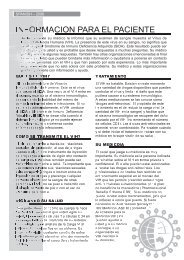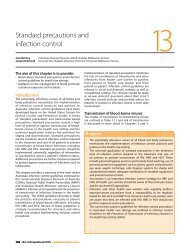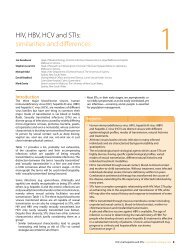B Positive – all you wanted to know about - ASHM
B Positive – all you wanted to know about - ASHM
B Positive – all you wanted to know about - ASHM
Create successful ePaper yourself
Turn your PDF publications into a flip-book with our unique Google optimized e-Paper software.
HEPATITIS B VIRUS-RELATED<br />
HEPATOCELLULAR CARCINOMA<br />
Monica Robotin The Cancer Council NSW and the School of Public Health, University of Sydney, Camperdown, NSW.<br />
Links <strong>to</strong>: Chapter 1: Prevalence and epidemiology of hepatitis B<br />
Chapter 6: Clinical assessment of patients with hepatitis B virus infection<br />
KEY POINTS<br />
� Worldwide, hepa<strong>to</strong>cellular carcinoma (Hcc) is the third most common cause of cancer-related<br />
mortality.<br />
� in australia, the Hcc incidence has been increasing over the last 20 years.<br />
� Hepatitis b virus (HbV)-associated Hcc may occur in non cirrhotic and, more commonly, in cirrhotic<br />
patients.<br />
� in nsW, the burden of disease is greatest in migrants from countries where HbV infection is endemic:<br />
people born in southern and eastern asia are 6<strong>–</strong>12 times more likely <strong>to</strong> be diagnosed with Hcc<br />
than australian-born people.<br />
� tradition<strong>all</strong>y, measuring serum alpha fe<strong>to</strong>protein levels and performing liver ultrasound have been<br />
used for Hcc screening.<br />
� despite a lack of agreement on whether screening improves disease-specific mortality, informal<br />
screening is widely practiced.<br />
� curative treatments for early stage Hcc include surgical resection, liver transplantation and<br />
percutaneous ablation of tumours.<br />
� systemic chemotherapy has a low response rate, but targeted chemotherapy infused through the<br />
hepatic artery may be effective in select cases.<br />
� the most effective prevention strategy is universal HbV vaccination.<br />
� there are effective treatments for chronic HbV; they may alter the course of the disease and they<br />
may reduce the incidence of end-stage liver disease and liver cancer.<br />
Worldwide, hepa<strong>to</strong>cellular carcinoma (Hcc) is<br />
the fifth most common cancer and the third<br />
most common cause of cancer-related death,<br />
with incidence rates two <strong>to</strong> three times higher<br />
in men than in women. 1 over 80% of Hcc<br />
worldwide is attributable <strong>to</strong> the combined<br />
effects of chronic hepatitis b and c infections.<br />
People with these infections have a 20 <strong>to</strong> 100fold<br />
increased risk of developing Hcc relative<br />
<strong>to</strong> those without these infections. 2,3 Hcc<br />
prevalence is highest in eastern asia, middle<br />
africa and some countries of Western africa,<br />
with large variations in Hcc incidence observed<br />
in different world regions. the estimated<br />
age-adjusted incidence rates of liver cancer<br />
per 100,000 men are approximately 10 times<br />
9<br />
higher in eastern asia, compared <strong>to</strong> the rates in<br />
australia and new Zealand. 4 Hepatitis b is the<br />
most common cause of Hcc worldwide and<br />
almost a third of <strong>all</strong> people with HbV infection<br />
live in china. annu<strong>all</strong>y, 300,000 chinese die<br />
from HbV-related conditions, including 180,000<br />
deaths from Hcc. 5<br />
in australia, the liver cancer incidence ranks<br />
fifteenth in males and twentieth in females,<br />
but incidence and mortality figures have<br />
progressively risen over the last two decades.<br />
in nsW, primary liver cancer incidence rates<br />
have been rising faster than rates for any<br />
other cancer, 6 surpassing cancers of the lung,<br />
mesothelioma, and brain and thyroid cancer. 7<br />
b <strong>Positive</strong> <strong>–</strong> <strong>all</strong> <strong>you</strong> <strong>wanted</strong> <strong>to</strong> <strong>know</strong> <strong>about</strong> hepatitis b: a guide for primary care providers 69






